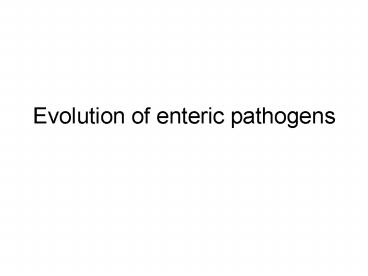Evolution of enteric pathogens PowerPoint PPT Presentation
1 / 14
Title: Evolution of enteric pathogens
1
Evolution of enteric pathogens
2
family Enterobacteriacea
- Genera
- Human, animal pathogens
- Salmonella, Yersinia, Aeromonas, E.coli/Shigella
- Commensals/symbionts of animals
- E.coli, Citrobacter
- Plant pathogens
- Erwinia
- Environmental bacteria
- Aeromonas, Klebsiella
- Why so different?
- Links to plant-related past?
- Most grow on plant-derived sugars
- Salmonella, E.coli cannot break down pectin.
Yersinia, Klebsiella can
3
Evolution of Salmonella
- Serovars are differentiated based on antigens
- O polysaccharide antigen
- H1, H2 flagella
- 2,501 serovars are recognized
- Some (sv Typhimurium, Newport) have a broad host
range - Gallinarum and Pullorum --gt chickens (fowl
typhoid) - Typhi, Parathyphi --gt primates (typhoid fever)
- Cholerasuis --gt pigs (pig paratyphoid)
- Dublin --gt cattle (bacteremia)
- Other svs are host-adapted
- Not all serovars are virulent
- Sv Bongori
- Sv Sophia
- Common in chickens in Australia, not known to
have caused disease in humans - All Salmonella have pathogenicity islands (SPIs)
4
SPIs
- SPIs Salmonella pathogenicity islands. Absent
in E.coli - SPI-1 carries genes involved in epithelial cell
invasion. 40-kb, chromosomal - mutants are virulent only if delivered by direct
injection - SPI-2 required for intracellular survival during
infection - even when injected, mutants are not fully
virulent - SPI-3 consists of 10 genes required for Mg2
acquisition and growth in macrophages. - Present in some serovars, lost from others
- SPI-4 carries 18 genes involved in survival
within macrophages - SPI-5 contains 6 genes, 4 of which are required
for enteritis in a calf model
5
Evolution of Salmonella relatedness of subspecies
Relatedness tree is based on the relatedness of
DNA sequences of multiple genes (loci)
I
major pathogens
enterocolitis, enteric fever
VI
II
IIIb
SPI-2
Gain of SPI-1
IV
VII
IIIa
S. bongori
V
Typically non-pathogenic
6
Evolution of Salmonella relatedness of subspecies
I differs from V by 8, E.coli from S. enterica
by 15 I and V diverged 65-75 mln yrs
ago Salmonella and E.coli diverged 120 mln yrs ago
I
major pathogens
enterocolitis, enteric fever
VI
II
IIIb
SPI-2
Gain of SPI-1
IV
VII
IIIa
S. bongori
V
Typically non-pathogenic
7
Evolution of virulence in E.coli
- Normally a commensal in human gut
- occupies large intestine and lower small
intestine - the only gut inhabitant using oxygen and thus
maintains anaerobiosis - virulent and commensal strains do not cluster
separately (i.e. many commensal strains have
closely related pathogens) - some E.coli sv are closely related to different
Shigella sp
8
Virulent E.coli strains
- Enterotoxigenic
- plasmid-borne genes for enterotoxins
- adhesin pili
- a non-invasive pathogenic E.coli
- Enteropathogenic.
- carry LEE island encoding proteins involved in
attachment, a protein injection system (Type 3) - EAF plasmid with genes for adherence
- Enterohemorrhagic
- LEE island carries a phage-encoded Shiga toxin
- virulence EHEC plasmid
- Enteroaggregative
- Enteroinvasive (include Shigella)
- carry pINV
- Unlike typical E.coli, Shigella cant utilize
lactose, mannitol are non-motile. - Most enteroinvasive E.coli have the same
deficiencies - Uropathogenic
9
EHEC O157H7
- Discovered in the 1980s
- Common in cattle.
- commensal in cattle
- pathogen in humans
- Virulence factors
- LEE
- stx (Shiga toxin) and EHEC plasmid are possibly
recent acquisitions - Evolution
- gained O157 by recombination,
- then split into two lineages sorbital-negative
and b-glucuronidase negative - both major lineages carry phage-encoded stx genes
10
How related are E. coli?
UPEC
Commensal
3
21
7.6
includes 247 islands gt1kB
39
3
7
17
includes 108 islands gt1kB
EHEC
Loosely based on Lan and Reeves, 2006
11
Evolution of Yersinia
- 11 species, only 3 are significant pathogens
- Y. pseudotuberculosis, Y. enterocolitica
- food-, waterborne pathogens that cause
gastroenterocolitis - share virulence factors not found in
non-pathogenic isolates - escape human immune system thanks to an outer
membrane protein encoded by a 70-kB virulence
plasmid - carry virulence determinants (production of
siderophore) on a High Pathogenicity Island (HPI) - HPI is highly mobile and was found in other
enterics - chromosomally encoded virulence factors also
present
12
Evolution of Yersinia
- Y. pestis
- causes plague
- transmitted by fleas
- a clone of Y. pseudotuberculosis.
Indistinguishable by common methods - distinct from Y. pseudotuberculosis in its
virulence strategy - colonizes flea gut.
- genes on pFra plasmid are involved
- is transmitted to a host through a bite
- reverse blood flow during biting due to partial
blockage of the fleas proventriculus. Blood
meal is regurgitated. hemin storage genes are
found in both Y. pestis and Y.
pseudotuberculosis - disseminates in blood from the infection site
13
Population genetics of enterics
- All bacterial populations are clonal to some
extent - Recombination
- important source of variation
- for enterics, recombination appears more
important then mutation - frequency differs for different species
- Neisseria -- frequent, Salmonella -- rare
- Through recombination clones adapt to specific
niches
14
Conclusions
- Many virulence determinants are carried on mobile
genetic elements - Pathogenicity islands, virulence plasmids are
shared between clones and species - Surface antigen polymorphism
- O antigen is the main target for immune system
and phages (high selective pressure) - Gene decay
- Genes mutate, and loss of function is OK
- e.g. Shigella is non-motile, cant utilize
lactose or decarboxylate lysine. - Occupies a different niche (inside a eukaryotic
cell) than commensal E.coli (in the gut of
mammals where lactose is found). Making flagella
is expensive, flagella is also an antigen

